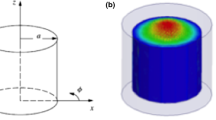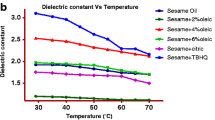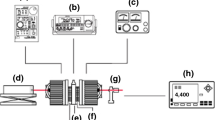Abstract
The dielectric properties of flaxseed, sunflower, mustard, rapeseed, and olive oils were studied in the temperature range 25–70˚C and in the frequency range of the electric field 25 Hz–1 MHz. A mechanism for the hardening of vegetable oils is proposed according to temperature-dielectric spectroscopy. The hardening of oils is interpreted as a combination of crystallization processes of triglycerides of saturated fatty acids and glass transition processes of triglycerides of unsaturated fatty acids. The glass transition temperature should be considered the true pour point, which allows setting the low temperature limit of the operability of vegetable oils as insulating liquids. Linear correlations between physicochemical, dielectric properties, and fatty acid composition of oils were established. The data presented can be used to assess the quality of vegetable oils, identify falsifications and to obtain oils with a balanced composition of fatty acids. The data derived can also be utilized in the selection of oils as oleochemical raw materials and for the development of compositions of electrical insulating liquids.




Similar content being viewed by others
REFERENCES
Shah, Z.H. and Tahir, Q.A., J. Sci. Res., 2011, vol. 3, no. 3, pp. 481–492. https://doi.org/10.3329/jsr.v3i3.7049
Corach, J., Sorichetti, P.A., and Romano, S.D., Int. J. Hydrogen Energy, 2014. V 39, no. 16, pp. 8754–8758. https://doi.org/10.1016/j.ijhydene.2013.12.036
Mohamad, N.A., Azis, N., Jasni, J., Ab Kadir, M.Z.A., Yunus, R., Ishak, M.T., and Yaakub, Z., J. Electrical Eng. Technol., 2016, no. 3, vol. 11, pp. 690–698. https://doi.org/10.5370/JEET.2016.11.3.690
Azmi, K., Ahmad, A., and Kamarol, M., J. Electrical Eng. Technol., 2015, vol. 10, no. 5, pp. 2105–2119. https://doi.org/10.5370/JEET.2015.10.5.2105
Angeline, D.R.P., Valantina, S.R., and Kumar, V.M., Int. J. Food Properties, 2017, vol. 20, no. 11, pp. 2805–2816. https://doi.org/10.1080/10942912.2016.1252921
Turky, G.M. and El-Adly, R.A., J. Molec. Liquids, 2017, no. 242, pp. 1–7. https://doi.org/10.1016/j.molliq.2017.06.126
Ragni, L., Iaccheri, E., Cevoli, C., Berardinelli, A., Bendini, A., and Toschi, T.G., J. Food Eng., 2013, vol. 116, no. 1, pp. 246–252. https://doi.org/10.1016/j.jfoodeng.2012.10.031
Kumar, D., Singh, A., and Tarsikka, P.S., J. Food Sci. Technol.-Mysore, 2013, vol. 50, no. 3, pp. 549–554. https://doi.org/10.1007/s13197-011-0346-8
Prevc, T., Cigic, B., Vidrih, R., Ulrih, N.P., and Segatin, N., J. Agricultural Food Chem., 2013, vol. 61, no. 47, pp. 11355–11362. https://doi.org/10.1021/jf402943b
Baida, A.A., Rudakova, A.V., and Agaev, S.G., Russ. J. Phys. Chem. A, 2013.V. 87, no. 2, pp. 240–244. https://doi.org/10.1134/s0036024413020076
Baida, A.A., Rudakova, A.V., and Agaev, S.G., Russ. J. Phys. Chem. A, 2013, vol. 87, no. 4, pp. 645–648. https://doi.org/10.1134/s0036024413040031
Mattson, F.H. and Lutton, E.S., J. Biol. Chem., 1958, no. 4, vol. 233, pp. 868–871.
Foster, R., J. Compilation. British Nutrition Foundation Nutrition Bull., 2009, no. 34, pp. 4–47.
Sakhno, L.O., Cytology and Genetics, 2010, no. 6, vol. 44, pp. 389–397.
Skanavi, G.I., Fizika dielektrikov (oblast’ slabykh polei) [Physics of Dielectrics (Region of Weak Fields)], Moscow: Gos. Izd Tekhn.-Teoret. Lit., 1949.
Ulrych, J. and Mentlik, V., 17th Int. Scientific Conf. on Electric Power Engineering (EPE), Prague, 2016.
Yang, J., Zhao, K.S., and He, Y.J., J. Food Eng., 2016, vol. 180, no. 47, pp. 69–76. https://doi.org/10.1016/j.jfoodeng.2016.02.012
Sonkamble, A.A., Sonsale, R.P., Kanshette, M.S., Kabara, K.B., Wananje, K.H., Kumbharkhane, A.C., and Sarode, A.V., Eur. Biophys. J. Biophys. Lett., 2017, vol. 46, no. 3, pp. 283–291. https://doi.org/10.1007/s00249-016-1165-7
Agaev, S.G., Sheveleva, M.G., and Shabrova, L.A., KhTTM., 1990, vol. 26, no. 11, pp. 600–603. https://doi.org/10.1007/bf00725905
Agaev, S.G. and Deryugina, O.P., Izv. Vuzov. Neft’ Gaz., 1991, no. 8, pp. 45–49.
Author information
Authors and Affiliations
Corresponding author
Ethics declarations
The authors declare that they have no conflict of interest.
Rights and permissions
About this article
Cite this article
Agaev, S.G., Baida, A.A., Georgiev, O.V. et al. Dielectric Spectroscopy of Vegetable Oils. Russ J Appl Chem 93, 748–756 (2020). https://doi.org/10.1134/S107042722005016X
Received:
Revised:
Accepted:
Published:
Issue Date:
DOI: https://doi.org/10.1134/S107042722005016X




